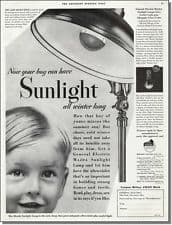Do you feel like adding another layer (or more) of fat? Do you feel like sleeping the winter away or maybe just lying on the couch? Would you rather be a bear and just hibernate? If so, you could have Seasonal Affect Disorder or SAD.
So, what is SAD and how can technology help?
SAD is a type of depression that occurs during the same season every year – usually during the winter months. Symptoms include feeling sad, grumpy, moody, losing interest in normal activities, eating more (remember the urge to hibernate?) and often craving carbohydrates. Other symptoms including gaining weight, sleeping more (but still feeling tired), and having trouble concentrating…
 SAD is caused by a lack of sunlight which upsets the sleep/awake pattern and other circadian rhythms. Briefly, a circadian rhythm is the 24-hour cycle of physical and mental changes that happen because of your “biological clock.” Lack of sunlight can also cause problems with the brain chemical, serotonin, which helps regulate moods. Seratonin is a neurotransmitter, which is a chemical produced by nerve cells in the brain. If the normal balance of the neurotransmitters is upset, the result can be headaches, depression and other mental health issues.
SAD is caused by a lack of sunlight which upsets the sleep/awake pattern and other circadian rhythms. Briefly, a circadian rhythm is the 24-hour cycle of physical and mental changes that happen because of your “biological clock.” Lack of sunlight can also cause problems with the brain chemical, serotonin, which helps regulate moods. Seratonin is a neurotransmitter, which is a chemical produced by nerve cells in the brain. If the normal balance of the neurotransmitters is upset, the result can be headaches, depression and other mental health issues.
Although SAD usually occurs in winter, it may also happen when one lives in a city where the skyscrapers keep natural light from reaching the sidewalks. It also happens in offices where the staff are located in the center of the building away from windows and natural light.

Most of us have heard of “light therapy,” and “sun lamps,” and think of them as a relatively new phenomena. However, as far back as 1929 Eveready was one company promoting a sun lamp. The quality of the early sunlamps varied from company to company and what sort of diodes were used. As it became more accepted that sunlight was important for health reasons, researchers also investigated clothing material that was the most beneficial for sunlight (linen and artificial silk) and vitamin D (the sunshine vitamin) began to be added to food,
The American Psychiatric Association has recognized the role that lack of sunlight plays in SAD and the treatment recommended? Much the same as the products in the 1930s – light boxes!
Replacing lost sunlight exposure resets the body’s internal clock. A light box emits light that is brighter than indoor lighting, but not as bright as direct sunlight. The many types of sun lamps have different purposes. Some are made to treat skin disorders and they emit more ultraviotet (UV) light. Light boxes for SAD should emit as little UV light as possible. Light boxes often use fluorescent or incandescent bulbs, but many now use LEDs. Most use white light, but there are also some that use the shorter wavelength blue light. Warning: tanning beds are not the same as a light box and should not be used as such.
Discussion over the benefits light therapy has included the worry that sun exposure contributes to skin cancer. There are now studies that suggest that some sunlight exposure will do more good than harm. Some researchers believe that exposure to sunlight and vitamin D might help with osteoporosis, and may help prevent many cancers, most of which are more deadly than skin cancer.
Interesting fact: Not only humans suffer from a lack of sunlight. In the late 1920s zoos began placing panes of glass in the animal cages. The result? Animals gravitated towards the natural light and began to have better appetites, fuller coats and better spirits.
So, instead of being a bear and hibernating this winter – find a way to soak up some vitamin D!
Resources:
Rreund, Daniel. American sunshine: diseases of darkness and the quest for natural light. 2012. Chicago : London : University of Chicago Press. Engineering Library QC911 .F83 2012.
Seasonal Affective Disorder (SAD) – Topic Overview. WebMD. Date accessed February 10, 2016.
Depression Health Center : Light Therapy – Topic Overview. November 14, 2014. WebMD.
Seasonal affective disorder treatment: choosing a light box. 1998-2016. Mayo Foundation for Medical Education and Research.

